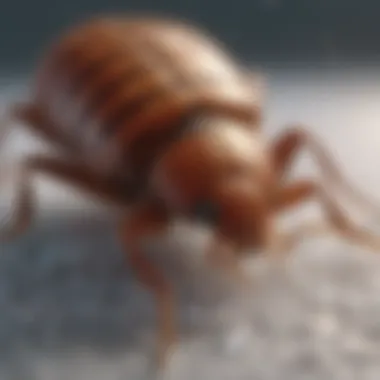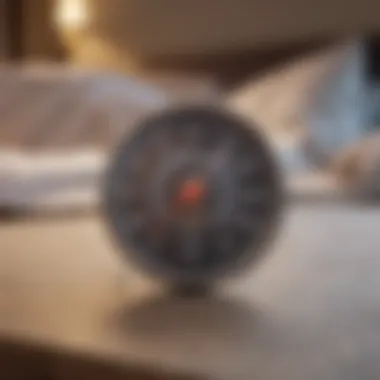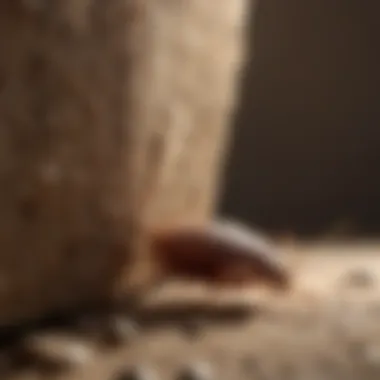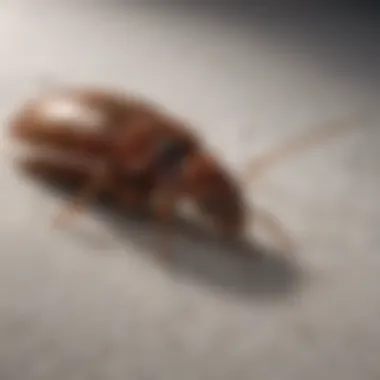Does Cold Temperature Kill Bed Bugs? An In-Depth Analysis


Preventive Pest Control Strategies
When it comes to safeguarding your home against pest invasions, employing preventive pest control strategies is key. Starting with house exterior protection, it is crucial to focus on sealing cracks effectively to prevent pests from finding their way indoors. Clearing any debris around your property is also essential as clutter provides hiding spots for pests. Additionally, implementing measures to deter pests from entering your home, such as installing door sweeps and ensuring window screens are intact, can significantly reduce the risk of infestations.
In terms of yard maintenance, regular upkeep of your outdoor spaces is imperative. Scheduling essential yard care routines like mowing the lawn, trimming bushes, and removing any standing water helps eliminate potential breeding grounds for pests. Utilizing methods such as pruning vegetation away from the house and keeping firewood stacked away from the foundation further discourages pests from taking residence in your yard.
Indoor cleanliness plays a paramount role in pest prevention. Expert cleaning tips and techniques involve decluttering, vacuuming regularly, and properly storing food to minimize attractants for pests. Maintaining a pest-resistant indoor environment includes sealing food containers tightly, fixing leaky pipes promptly, and inspecting and repairing any cracks or gaps in walls or around baseboards.
Efficient garbage disposal methods are essential in deterring pests. Proper waste disposal not only eliminates potential food sources for pests but also helps in maintaining overall hygiene in and around your home. It is crucial to use tight-fitting lids on trash cans, compost bins, and recycling containers to prevent pests from accessing them.
Innovative ways to safeguard your home beyond traditional methods are continually being explored. Utilizing techniques such as ultrasonic pest repellers, installing mesh screens on vents, and using natural repellents like vinegar or peppermint oil can serve as additional layers of defense against pests.
Introduction
This section sets the tone for understanding the effectiveness of cold temperatures in eradicating bed bugs. Cold treatment is gaining recognition as a non-toxic and efficient method for controlling bed bug infestations. With the rise of concerns over chemical treatments, exploring the impact of cold on bed bugs is pivotal in implementing successful pest management strategies.
Understanding Bed Bug Infestations
Bed bug infestations pose a grave challenge with their ability to proliferate rapidly, leading to widespread nuisance and discomfort. Understanding their lifecycle sheds light on crucial points for effective control measures.
Lifecycle of Bed Bugs
The lifecycle of bed bugs encompasses various stages from egg to nymph to adult, with distinct characteristics at each phase. This intricate progression plays a significant role in devising targeted eradication strategies. Recognizing the vulnerabilities at different life stages is key to breaking the reproductive cycle and curbing infestations.
Signs of Bed Bug Infestation
Identifying the signs of a bed bug infestation is essential for prompt intervention. From distinctive bites on the skin to tell-tale fecal stains on bedding, being aware of these indicators aids in early detection, preventing further spread of these pests. Educating oneself on these signs enhances vigilance and facilitates timely mitigation efforts.
Risks Associated with Bed Bug Infestations
Beyond the physical discomfort caused by their presence, bed bug infestations carry psychological and social implications. Dealing with the stigma of infestations and potential health risks from bites amplifies the urgency of eradication measures. Understanding these risks underscores the importance of swift and effective control strategies to safeguard both physical and mental well-being.
Current Pest Management Methods
In combating bed bug infestations, various pest management methods are employed, each with its strengths and limitations. We delve into the existing strategies to assess their viability in addressing this persistent challenge.
Chemical Treatments


Chemical treatments have long been a mainstay in pest management due to their rapid impact on insect populations. However, concerns over chemical resistance and environmental repercussions have fueled the search for alternative approaches. While effective, the potential risks associated with chemical treatments necessitate a comprehensive evaluation of their long-term efficacy.
Heat Treatment
Utilizing heat to eliminate bed bugs has gained popularity for its ability to penetrate inaccessible areas and eradicate pests at all life stages. By exposing infested spaces to high temperatures, heat treatment offers a non-toxic alternative with promising results. However, proper application and monitoring are critical to ensure thorough eradication and prevent reinfestation.
Cold Treatment
Among the emerging methods, cold treatment stands out for its non-toxic nature and minimal impact on the environment. By subjecting infested areas to freezing temperatures, bed bugs can be effectively eliminated without the use of chemicals. The controlled application of cold treatment offers a compelling solution for households seeking eco-friendly pest control options. However, understanding the intricacies of cold exposure and its impact on bed bugs is vital for achieving optimal results.
The Science Behind Cold Treatment
Cold treatment plays a pivotal role in eradicating bed bugs effectively, making it a noteworthy aspect of this comprehensive guide. By delving into the scientific underpinnings of cold treatment, one can appreciate its significance in pest management strategies. Understanding the mechanisms through which cold affects bed bugs is essential for implementing successful control methods. As a non-toxic alternative, cold treatment offers a safe and efficient approach to combating bed bug infestations. This section aims to elucidate the key elements and considerations surrounding the science behind utilizing cold temperatures to eliminate bed bugs.
Effects of Cold on Bed Bugs
Impact on Bed Bug Metabolism
Examining the impact of cold on bed bug metabolism reveals a fundamental aspect of cold treatment efficacy. Cold temperatures disrupt the metabolic processes of bed bugs, ultimately leading to their demise. This disruption in metabolism hinders the bed bugs' ability to feed, reproduce, and survive, making cold treatment an impactful choice. The unique feature of targeting bed bug metabolism sets cold treatment apart as a method that effectively incapacitates these pests. While advantageous in exterminating bed bugs, this approach may require thorough application to ensure comprehensive elimination.
Freezing Temperature Thresholds
Understanding the freezing temperature thresholds for bed bugs is imperative in cold treatment applications. Specific temperatures must be reached to guarantee the complete eradication of bed bug populations. These freezing thresholds ensure that no bed bugs can survive the cold treatment, providing a reliable method for pest control. By highlighting these critical temperature ranges, it becomes evident why freezing is a popular and effective choice in addressing bed bug infestations. However, maintaining these temperatures consistently throughout the treatment process is vital to achieving successful outcomes.
Survival Rates of Bed Bugs in Cold Environments
Assessing the survival rates of bed bugs in cold environments sheds light on the resilience of these pests. Understanding how bed bugs fare under varying cold conditions enables practitioners to devise tailored cold treatment strategies. Factors such as duration of exposure and temperature consistency significantly impact bed bug survival rates, influencing the effectiveness of cold treatment. By exploring the survival behavior of bed bugs in cold environments, one can refine cold treatment protocols to maximize extermination rates while considering the potential limitations of this method.
Factors Influencing Cold Treatment Success
Duration of Cold Exposure
The duration of cold exposure is a critical factor influencing the success of cold treatment against bed bugs. Longer exposure periods ensure that all life stages of bed bugs are effectively targeted, enhancing the treatment's overall efficacy. By extending the exposure duration within optimal temperature ranges, practitioners can achieve thorough eradication of bed bug populations. However, balancing the duration of cold exposure with practical considerations is essential to avoid drawbacks such as prolonged treatment times.
Consistency of Temperature
Maintaining consistent temperatures during cold treatment is paramount to ensuring its success. Fluctuations in temperature can compromise the effectiveness of the treatment, allowing bed bugs to survive and potentially reinfest the environment. Consistency in temperature control optimizes the extermination process, guaranteeing reliable results in eradicating bed bugs. Emphasizing the importance of temperature consistency underscores the meticulous approach required in implementing cold treatment strategies effectively.
Inspection and Preparation Strategies


The thoroughness of inspection and preparation strategies significantly influences the outcomes of cold treatments for bed bug control. Comprehensive inspections help identify the extent of infestations and areas requiring targeted cold exposure. Adequate preparation, such as removing clutter and ensuring proper sealing of treated spaces, enhances the efficacy of cold treatment. By employing meticulous inspection and preparation measures, practitioners can streamline the cold treatment process and maximize its impact in eradicating bed bugs from infested spaces.
Implementing Cold Treatment
Cold treatment is a pivotal aspect of bed bug control strategies, especially for environmentally conscious individuals seeking non-toxic methods. In the realm of pest management, implementing cold treatment stands out as a safe and effective means of eradicating bed bug infestations. By delving into the intricacies of cold treatment procedures, individuals can better understand the nuances of this approach and its benefits over traditional chemical methods.
Cold Treatment Procedures
Preparation Steps:
Preparation steps play a critical role in ensuring the success of cold treatment. This phase involves meticulous inspection and de-cluttering of the infested area to maximize the impact of cold exposure on bed bugs. Thorough preparation sets the foundation for a successful treatment by negating potential hiding spots for bed bugs, thus increasing the efficiency of the cold treatment process.
Application of Cold:
The application of cold involves the targeted delivery of cold temperatures to the infested areas. This can be achieved through innovative techniques such as freezing devices or cryonite applications. Precise application ensures that bed bugs are exposed to lethal cold temperatures, effectively disrupting their life cycle and population.
Monitoring and Assessment:
Monitoring and assessment post-treatment are crucial to ascertain the effectiveness of cold treatment. Regular monitoring of the treated area enables individuals to track the reduction in bed bug activity and assess the need for any follow-up treatments. Through meticulous assessment, individuals can gauge the success of cold treatment and make informed decisions for further pest management strategies.
Benefits of Cold Treatment
Non-Toxicity:
The primary advantage of cold treatment is its non-toxic nature. Unlike chemical treatments that pose health risks to residents and pets, cold treatment offers a safe alternative without the use of harmful substances. This makes it an ideal choice for households with children, pets, or individuals sensitive to chemical exposure.
Cost-Effectiveness:
Cold treatment proves to be cost-effective in the long run due to its efficacy in eliminating bed bugs with minimal repeat treatments. While the initial investment may be higher than traditional methods, the reduced need for multiple applications and minimal re-infestation rates make it a cost-efficient choice over time.
Minimal Preparation Requirements:
The minimal preparation requirements for cold treatment simplify the process for homeowners. Unlike heat treatments that may necessitate evacuation or removal of certain items, cold treatment typically requires basic preparatory steps such as vacuuming and clearing clutter. This ease of preparation makes cold treatment a convenient option for busy individuals seeking efficient bed bug control methods.
Challenges and Limitations
In this comprehensive guide on the effectiveness of cold temperatures in eradicating bed bugs, it is crucial to delve into the challenges and limitations associated with cold treatment. Understanding these factors is essential for implementing successful pest management strategies and making informed decisions when dealing with bed bug infestations.


Challenges in Cold Treatment
Effectiveness in Extreme Infestations
Effectiveness in extreme infestations poses a significant challenge when considering cold treatment for bed bug control. In highly populated areas of bed bugs, the efficacy of cold treatment may be diminished due to the sheer number of insects present. This requires precise application and monitoring to ensure that all bed bugs are effectively eradicated, highlighting the need for thorough planning and execution.
Impact on Hard-to-Reach Areas
The impact of cold treatment on hard-to-reach areas presents another obstacle in the eradication process. Bed bugs can hide in intricate spaces such as wall voids, electrical outlets, or cracks and crevices, making it challenging for cold temperatures to penetrate and target these hidden breeding grounds effectively. Strategies such as proper insulation and targeted application are vital to address this challenge and achieve comprehensive elimination of bed bugs.
Risk of Re-Infestation
One of the primary concerns with cold treatment is the risk of re-infestation. Even though cold treatment can effectively kill existing bed bugs, there is a possibility of dormant bed bug eggs or surviving insects leading to re-infestation if not adequately addressed. This emphasizes the importance of follow-up procedures and comprehensive strategies to prevent the recurrence of bed bug infestations.
Combination Strategies for Enhanced Results
To maximize the efficacy of cold treatment in eradicating bed bugs, integrating cold treatment with other methods is a crucial aspect to consider.
Integrating Cold Treatment with Other Methods
By combining cold treatment with other pest management techniques such as heat treatment or chemical treatments, a synergistic effect can be achieved, enhancing the overall effectiveness of bed bug control. This integrated approach targets different aspects of the infestation, leading to more comprehensive eradication results and reducing the likelihood of resistance development in bed bug populations.
Follow-up Procedures
Following cold treatment, implementing robust follow-up procedures is essential to monitor the success of the treatment, detect any potential re-infestations, and address any residual bed bug populations effectively. Regular inspections, ongoing prevention measures, and thorough monitoring protocols contribute to long-term success in maintaining a bed bug-free environment.
Conclusion
Cold treatment for bed bugs offers a non-toxic and effective approach to eradicating infestations, presenting a viable alternative to chemical or heat treatments. Understanding the science behind cold treatment is paramount for successful pest management strategies. By delving into the impact of cold temperatures on bed bugs, it becomes evident that cold treatment is not only safe but also environmentally friendly. Owing to its efficiency, minimal preparation requirements, and cost-effectiveness, cold treatment stands out as a promising method in the realm of pest control.
Summary of Cold Treatment Efficacy
Key Takeaways
When considering cold treatment for bed bug infestations, key takeaways reveal significant advantages. The preservation of a non-toxic environment by utilizing cold treatment is a crucial benefit. The ability to avoid harsh chemicals while effectively eliminating bed bugs is a standout feature of this approach. Additionally, the low impact on the surrounding environment makes cold treatment a popular choice for those seeking sustainable pest management solutions.
Future Implications
Looking ahead, the future implications of cold treatment showcase its potential for further development and integration into pest control practices. With ongoing research and advancements in technology, cold treatment may become even more precise and efficient. The ability to address bed bug infestations without long-term environmental consequences is a key advantage that can shape the future of pest management practices.
Final Thoughts
Considering Cold Treatment for Bed Bug Control
The consideration of cold treatment for bed bug control offers a proactive approach to pest management. By prioritizing non-toxic methods that are both effective and environmentally conscious, cold treatment emerges as a beneficial choice. The unique feature of cold treatment lies in its minimal impact on indoor environments and its ability to provide long-lasting results. Despite some challenges, such as effectiveness in extreme infestations, the advantages of cold treatment for bed bug control make it a compelling option for those seeking sustainable and efficient pest control solutions.



